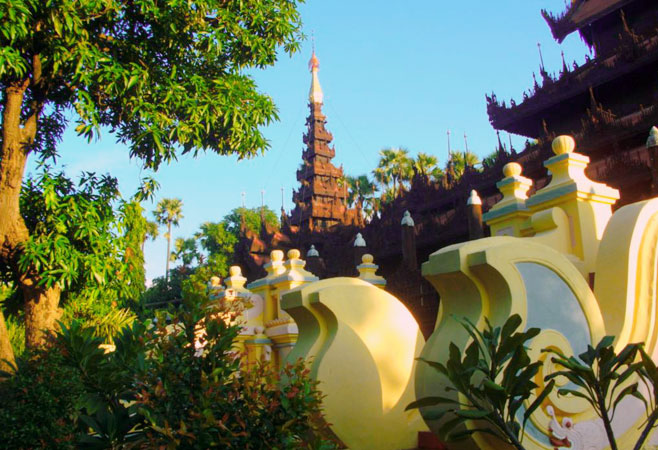Mandalay Attractions

Throughout Myanmar, Mandalay Shwe-gyi-do Quarter is the best place for embroidery and appliqué work. Materials used in embroidery and appliqué workers include, golden silvery thread, sequins (plastic metal) velvet, satin, colored cloth, paper produced in Shan State and glue from sticky rice. In making an embroidery cloth or a tapestry, the cloth has to stretch on a wooden frame, about one foot high above the ground and embroider on it...

The marble carving workshop is near Mahamuni Pagoda. Marble are from the Sagin quarry about 35 miles (56km) north of Mandalay. Many religious items, mainly Buddha images and stone slabs for inscription, are produced. Other figures such as images of other religions, animal figures are also made by...

Shwesayan Pagoda is located on the Mandalay- Lashio Highway road. It was built by Queen Saw Mon Hla of Bagan. This pagoda is built in mountainous area, but it has a historical value depicting King Anawrahta of Bagan. The Shwesayan Pagoda Festival is a very interesting festival indeed: a typical rural fair, bringing many visitors from...

Nga Yant Min Cave & Yankin Hill
The Yankin Hill is located in the east of Mandalay. Yankin Hill meaning “away from danger”, shows harmony and tranquility of Mandalay. Nga Yant Min Cave is situated at Yankin Hill, about 5 miles (8km) east of Mandalay and 884ft (269m) above the sea level. There are many carved figures of fishes on the hill, placed by Min Shin Saw, son of King Alaung Sithu during the Bagan Era. It is believed that the first figures of the fishes were...

Mandalay is the only place to find Gold Leaf making industry. Total of 2000 very thin gold leaves can be obtained from a tickle of 24 karat pure gold after seven hours of pounding in many different steps during the process. This is the industry not being able to replace with modern machine and tourists have very good interest to this...

This is a historical Jetty of ancient Mandalay, used by the British to put an end to the Third Myanmar Empire. Gaw Wein means west gate or the west entrance of Mandalay. King Thibaw was exiled to India from this jetty by the British. This jetty is located at the corner of 35th Street and Strand Road in Mandalay. (Source:...

Bronze Casting can be studied at a place called Tampawadi between Mandalay and Amarapura. Buddha images, bells, gongs, tri gongs, and other figures such as images of the nat (spirit) and of famous persons are cast here. (Source:...

A short distance south-west of the Zegyo Market on 85th St, this pagoda rises from an elevated masonry platform. It was badly damaged during World War II, but was subsequently repaired. Its main point of interest is the five-metre-high seated Buddha image cast in bronze by King Bagyidaw in Inwa in 1823 just before the First Anglo-Burmese War broke out. In 1849 King Bagan Min moved the image to Amarapura, just as the second war was about to begin. When...

Located on 24th St between 82nd and 83rd Sts, a little north-east of Zegyo Market or the clock tower, this pagoda’s original construction pre-dates Mandalay itself. It was founded in 1167 by Prince Minshin Saw during the Bagan period. He was the exiled son of King Alaungsithu and settled near the present site of Mandalay. The shrine is notable because it contains the original Buddha image consecrated by the prince. It also contains many other images, made of gold, silver...

Shweinbin Monastery is located at the southwest corner of Mandalay City. This attractive monastery built in traditional Myanmar architecture is one of the few buildings that have survived the test of time. Constructed in 1895 by Chinese merchants, the monastery consists of many impressive woodcarvings and also contains a number of admirable works of art. (Source:...

King Mindon (1852-1872) founded a new capital on 16 June 1858. In founding the new capital, he established seven monuments simultaneously. They were the following: 1. The city 2. The moat 3. Mahalokamarajain pagoda 4. The ordination hall 5. The monastery 6. Pitaka taik or Royal library 7. Sudhamma Zayat or Rest-house On 27 April 1859 King Mindon issued and order to build seven monuments simultaneously. On 15 May 1859, the pits were dug for the seven monuments to lay...

Kyauktawgyi Pagoda means the Pagoda of the Great Marble Image. It is also known as Maha Thetkya Marazain Pagoda. Kyauktawgyi Pagoda built by King Mindon stands at the foot of Mandalay Hill. The Image was carved out of a huge single block of marble. It took three years from 1863 to 1865. The Pagoda is so-called because it houses a large image of the Buddha sculpted from a single block of beautiful Sagyin marble. In the brick pyathats on the...
Ask a Question?
Feature destinations
WHY MYANMAR TOUR WITH US?
- We are internationally registered, well-recognized
- We respond you within 12 hours
- Local experts, true knowledge
- Our service is personalized, customized at its best
- Easy to pay online
- Best customer care/policy
- Committment to Satisfaction
- Professional Consultancy
- Unrivalled values















